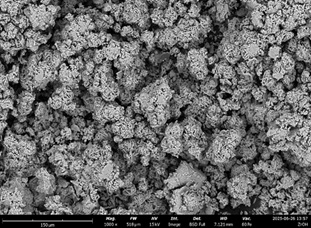From Zircon Sand to Advanced Functional Materials: Synthesis and Characterization of Zirconium-Based Metal Organic Frameworks
Abstract
This study presents an integrated approach for converting zircon sand into functional materials based on zirconium metal–organic frameworks (Zr-MOFs). Zirconium was extracted through three main steps: alkali fusion, water leaching, and nitric acid leaching, resulting in a precursor identified as Zr(OH)2(NO3)2·1.33H2O (ZON). Characterization using XRF, FTIR, XRD, and SEM-EDX revealed that ZON possesses a high zirconium content (94.87% relative to the total metal content) and distinct structural features. The ZON compound was subsequently utilized as a novel precursor in synthesizing of three types of Zr-MOFs: UiO-66, MOFs-801, and MOFs-808. Structural and morphological analyses indicated that all three MOFs were successfully formed with high crystallinity. These findings demonstrate that locally sourced zircon sand has strong potential as a sustainable and cost-effective raw material for MOF synthesis, while also bridging the knowledge gap between zirconium extraction and the development of sustainable materials chemistry based on local mineral resources.
Downloads

Copyright (c) 2025 Berryl Vendo Palapessy, Brilyan Muhammad Rasyid Reda, Fainan Failamani, Aep Patah

This work is licensed under a Creative Commons Attribution-NonCommercial-NoDerivatives 4.0 International License.
Authors who publish with this journal agree to the following terms:
- Copyright on any article is retained by the author(s).
- The author grants the journal, the right of first publication with the work simultaneously licensed under a Creative Commons Attribution License that allows others to share the work with an acknowledgment of the work’s authorship and initial publication in this journal.
- Authors are able to enter into separate, additional contractual arrangements for the non-exclusive distribution of the journal’s published version of the work (e.g., post it to an institutional repository or publish it in a book), with an acknowledgment of its initial publication in this journal.
- Authors are permitted and encouraged to post their work online (e.g., in institutional repositories or on their website) prior to and during the submission process, as it can lead to productive exchanges, as well as earlier and greater citation of published work.
- The article and any associated published material is distributed under the Creative Commons Attribution-NonCommercial-NoDerivatives 4.0 International License.





_copy1.png)










